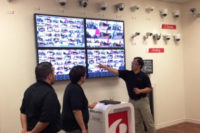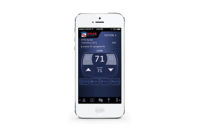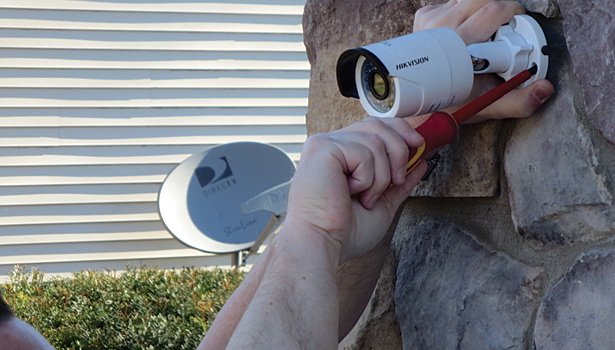More Homeowners Seek to Extend Security Outside of Residences
First line of defense.

Today’s homeowners are much more comfortable with cameras, and dealers report getting more requests for them. Shown: Select Security technician, William Beahm, installs a camera in a residential location.

Today’s homeowners are much more comfortable with cameras, and dealers report getting more requests for them. Shown: Select Security technician, William Beahm, installs a camera in a residential location.

In this installation by Automated Security Alert, aesthetics was a top priority for the homeowner. The hillside to the right of the pool has eight cameras installed in addition to 12 rock speakers. The shot looking towards the golf course has two cameras and six rock speakers. Automated Security Alert met the challenge of creatively camouflaging all of them.

In this installation by Automated Security Alert, aesthetics was a top priority for the homeowner. The hillside to the right of the pool has eight cameras installed in addition to 12 rock speakers. The shot looking towards the golf course has two cameras and six rock speakers. Automated Security Alert met the challenge of creatively camouflaging all of them.






The realm of residential security is expanding outside the four walls of the home. More homeowners are requesting cameras, garage door sensors, gate controls, and even outdoor sensors that can allow the monitoring of pools, gates, and other areas. These all extend the residential security perimeter well outside the physical structure of a residence, and strengthen the security available to the homeowner.
Outdoor residential security is really the first line of defense of any homeowner’s security, says Carl Sandulli, Automated Security Alert Inc., Munhall, Pa. “The home itself, of course, has full security, but the outdoors often needs to be addressed as well,” he emphasizes.
There are more technologies available today than in past years for dealers to tap into — and more homeowners are educated on the options. “Homeowners are starting to understand these technologies — that you can expand outward from the home,” observes Jeff Davies, general manager, Beutler Corporation – Low Voltage Division, McClellan, Calif., a company that was started in the garage of Del Beutler’s home in 1947.
“When you think about outdoor security, you may think of older, traditional, somewhat service-heavy products that generated more false alarms and weren’t as installer or environmentally friendly,” says Patrick Egan, owner and chief executive officer of Select Security, Lancaster, Pa. “But today’s outdoor perimeter protection involves a whole new arsenal of high-tech devices, including cameras that are analytically equipped to set up geo-fencing and human detection and motion sensor detectors for outdoors,” Egan describes.
He describes the first line of defense outside of a home as the yard sign or sticker notifying everyone that the premise is under surveillance. The next line of protection is the virtual perimeter protection that can be activated anywhere on the property around the home using cameras.
“I’m not talking about post-incident cameras. I am talking about live-incident cameras, like the Videofied product that snaps a picture and sends it along to the homeowner or the central station right away,” Egan says. “We have hundreds of those cameras installed. By strategically placing Videofied’s MotionViewer® cameras, there immediately is a picture sent to the homeowner or central station. If it is a deer or the wind, you know, reset, and move on. But if it’s a person — boom — now you have a hit, now you have protection,” Egan says. See related story, “Peace of Mind in the Pocono Mountains” on page 94 .
James Bienenfeld, York Security Solutions, Miami Beach, Fla., is using the Bosch Security Systems’ Intelligent Video Analysis (IVA) embedded in its cameras to offer edge-based, real-time processing that identifies alert conditions for homeowners. The IVA both creates the opportunity to glean more information from the cameras and reduces false alarms.
Bienenfeld points out that the only scenario worse for a homeowner than not having a system to alert them when something is happening is to have a system that alarms falsely and triggers without providing any information about what is happening.
“Once peace of mind is disturbed — especially at night — you are terrified and your pulse is 150. You are almost better off having nothing,” he says.
That is where the IVA comes in. Bienenfeld uses cameras and has them come in as a point on the alarm system. The analytics do more than motion detection; they “watch” for objects of the right size to move in the right direction.
“A lot of people want cameras looking into the back yard, but you can’t know if something is happening unless you are looking at the camera, so changing the function to a motion sensing, analytically driven detector gives you a lot more information than something you don’t see or can’t check on,” he says.
Because the camera is connected to the panel, the system can sound off like an alarm with motion, trigger the panel, alert the central station or the homeowner, and perform many other functions.
Today’s residential customers are getting more comfortable with cameras. “Homeowners actually want to see cameras at the front door, cameras at the back door, even cameras at the garage. Not only are we going back and doing upgrades to systems, but we are also working with builders to have cameras as an option on new homes,” Davies describes.
His company also uses the Copper Cop™ from Linear LLC, Carlsbad, Calif., to protect the copper in larger HVAC units for large residential homes. Linear’s Copper Cop™ consists of a 30-foot cable harness with eight self-tapping screw-in clip assemblies, connected to a weatherproof alarm interconnect box. The system is ready to accept a wireless alarm transmitter or hardwired connection to a security alarm panel. Once Copper Cop™ is installed on the exterior of the HVAC unit and activated, removal of the HVAC unit cover or tampering with the cable triggers an alarm.
Cameras were the No. 1 request from homeowners according to dealers polled by SDM. See “Cameras Dominate Outdoor Residential Security Requests” on this page. The poll asked dealers to rank requests for cameras against requests for garage door sensors, gate sensors, automated lighting tied into the system, and driveway sensors.
Garage doors sensors, ranked as the third most popular request of homeowners by the dealers SDM surveyed are a growing market, Davies says. “People love to see remotely that the garage door is open or closed.”
Honeywell, Melville, N.Y., is offering sensors for garage doors that tie into the security panel. The 5822T Wireless Tilt Sensor mounts vertically on surfaces that tilt horizontally when opened, providing a way to secure garage doors or tilt windows. Whenever the sensor detects tilt movement, a notification is transmitted to the control panel. Homeowners can know if their garage doors or tilt windows are opened or closed correctly at their security system keypads, or, if using Honeywell Total Connect™ Remote Services, they can check status and receive email alerts or text messages on their smartphones, tablets or other compatible wireless mobile devices.
To create higher security at a remote hunting lodge in Louisiana, Thomas Marino, president, Advanced Technologies, Baton Rouge, La., utilized multiple technologies, including Leviton OmniPro II security and automation systems with voice boards, outdoor motion detectors, cameras, and outdoor speakers.
Marion installed a Leviton Cellular Communication Center and a WR21 Digicon Industrial high temp LTE Verizon Modem for Internet. The camp also utilizes strategically positioned Leviton surveillance cameras, motion detection, a digital video recorder, and voice annunciation.
“If someone steps on the deck and the system is armed, it will speak saying ‘Leave now’ or whatever recorded message is preferred. At the point they walk on the deck they already have their image captured, while another camera captures the boat identification number as it pulls up to the dock. There is also a warning that their picture has already gone off-site so they don’t consider grabbing the cameras or DVR,” Marino describes.
By getting creative and utilizing all of the new technologies available today, dealers can offer comprehensive security systems that not only create a valuable first line of defense, but enhance their customers’ peace of mind.
Managing Aesthetics With Outdoor Installations
When installing outdoor security equipment, especially at large homes, don’t be surprised if you have to work with a designer or landscape architect, advises Automated Security Alert’s Carl Sandulli, who frequently has navigated homeowners’ and designers’ expectations while installing outdoor systems.
Recently, Sandulli worked with a homeowner who was “a real stickler” about not wanting to see any cameras or speakers in the outdoor system.
“We had talked about the traditional type of cameras that you would see on a home or a building and he didn’t want to have any of that. So, everything we did was installed from the landscaping perspective. It was an interesting challenge you might not anticipate,” Sandulli recalls.
His team created custom shapes and colors for the camera housings to allow them to blend optimally into the landscape. The shrubbery and landscaping elements also were used strategically.
“We enjoy the challenge of working with designers because when you’re done it’s interesting to witness the reveal process. Whenever the designers reveal everything to the homeowners and they hear sounds from the speakers or they know that there is security, but they look around and they can’t see anything, I sort of enjoy seeing that look on their face,” Sandulli shares.
Peace of Mind in the Pocono Mountains
Select Security recently secured a vacation home in the Pocono Mountain area for a high-level official who had received threats and needed additional security when going to the home on the weekends. The location has no close response from FBI officials or the local area state police. Because the official did not want to have a guard 24/7 at the house, Select Security needed to establish “that first line of defense,” which utilized cameras hundreds of yards away from the house.
Multiple cameras around the property — installed high in trees or disguised in birdhouses — create a secure perimeter around the property.
“Because we did birdhouses as camouflage, we had to put some real birdhouses with birdseed in other locations to draw them away. We also utilized hollowed-out trees. You put a small weather enclosure around the cameras, spray-paint them dark brown, green, black — or whatever color best suits the environment — and even the squirrel doesn’t know it is there,” Egan describes.
Looking for a reprint of this article?
From high-res PDFs to custom plaques, order your copy today!













